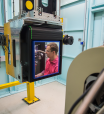
Showing 641 - 660 of 1319 results
Join ANSTO for a sensational week of science fun online

High Performance Macromolecular Crystallography Beamline (MX3)
The High Performance Macromolecular Crystallography beamline will enable the study of very small (sub-5 micrometre) or weakly diffracting crystals, providing a state-of-the-art high-throughput facility for researchers. MX3 will be able to study the structures of large proteins and protein complexes for virology, drug design and industrial applications via goniometer mounted crystals, in-tray screening, or via serial crystallography methods.

Hot Isostatic Pressing
Hot Isostatic Pressing supports advanced manufacturing by increasing a material's density and reducing porosity. This capability complements ANSTO’s extensive suite of instruments and techniques for characterising materials and final products.
2000 year global temperature record published
Lake sediments as environmental archives used in compilation of data.

Role at ANSTO

Laboratory Safety
All safety requirements must be met while working at the Australian Centre for Neutron Scattering. Failure to do so may result in the suspension of experiments.
ANSTO star to shine bright on international stage
ANSTO’s Siobhan Tobin has been awarded the 2019 Rhodes Scholarship for Victoria which is one of the most prestigious scholarship programmes internationally.
Award-winning research publication on superalloys
Industrial Engagement Manager at ANSTO and Professor in Advanced Structural Materials at the University of Sydney, Anna Paradowska is among the authors who contributed to a 2019 paper that was recently awarded the ASM International ASM Henry Marion Howe Medal in Metallurgical and Materials Transactions A.
Graduate Profile - Robert Raposio
A desire to give people around the world greater access to the benefits of nuclear medicine is behind Robert Raposio and his research into producing radioisotopes in more efficient, cheaper and sustainable ways.
Sutherland students ‘armed’ with skills to build a bionic hand
Global honour for ANSTO researcher
Prof Lyndon Edwards recognised for for excellent sustained contribution to materials engineering
ANSTO scientists share Australian research with students on World Environment Day
Big boost in jobs and funding for Innovation Precinct
Jobs supported through the nandin Innovation Centre at ANSTO have skyrocketed 360 per cent since opening, with member businesses raising more than $3.9 million in capital, in a major boost for the local Sutherland Shire economy.
Innovative approach to assess how diet of pregnant woman might impact foetal development
From pizza slices to precision welding: Young apprentice blazes a trail to qualified tradesperson in record time
Synchrotron techniques reveal amount of carbon captured in microscopic seams of deep-sea limestone
A collaboration of Australian scientists has used ANSTO’s Australian Synchrotron to measure the amount of carbon that is captured in microscopic seams of deep-sea limestone, which acts as a carbon sink.
Energy use and emissions
Detailed data on ANSTO electricity use and CO2 emissions for FY2022 - FY2023

Highlights - Magnetism
Highlights of the Magnetism Project.
Keeping every pill consistent & compliant
How well do you know the chemical makeup of your product – batch to batch, dose to dose – or even within one pill or capsule?